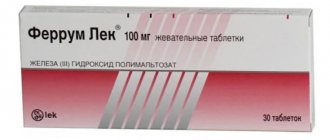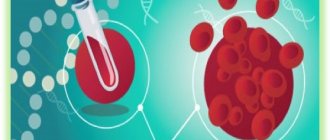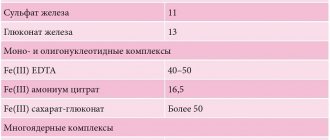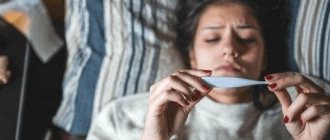Proteins, fats and carbohydrates are the main nutrients that are the building material and source of energy for all living things. But an equally significant biological role belongs to mineral substances. Despite their insignificant presence in the human body, they take part in numerous reactions and metabolic processes, and therefore are absolutely necessary for normal functioning in any period of life. Minerals are part of enzymes, hormones and other biologically active molecules, which, like conductors, direct and regulate metabolic processes. There are 81 chemical elements found in the human body, and the stability of their regular supply is a prerequisite for health. Minerals are not synthesized independently; they come from outside and are absorbed with food and water. A sufficient amount of them is especially important during periods of active growth and development, which determines the importance of a rational and balanced diet for pregnant women and children, because a deficiency of even one of the elements can adversely affect health.
Biological role of iron
According to the amount of required content in the body, all minerals can be divided into microelements (for example, zinc, iodine, fluorine, copper, selenium, manganese) - these are dispersed minerals, their presence in the body is minimal, as well as macroelements (for example, calcium, phosphorus, magnesium , sodium, chlorine and sulfur) - their concentration is several times higher than that of the previous group. “Small is the spool, but expensive,” this proverb reflects the fact that, despite the minimal concentrations in the body, the biological role of minerals is very great. One of the most important minerals is iron. This is a microelement; on average, an adult has about 4 grams of it. And in terms of per kilogram of weight, the largest amount of iron in tissues is observed during the newborn period, when the baby is born with a supply of the element acquired from the mother during intrauterine development. The bulk of iron is found in the blood in the structure of hemoglobin. This protein binds to oxygen to transport it to every cell of the body, ensuring tissue respiration, and therefore the functioning of all organs and systems. Then, having given up oxygen, hemoglobin combines with carbon dioxide and transports it for subsequent release by the lungs from the human body. It is hemoglobin that colors blood red. In addition to blood cells, iron is found in the bone marrow, liver, muscles and spleen. This mineral is part of enzymes that accelerate DNA synthesis during cell division.
IMPORTANT! The effective operation of these structures is especially necessary during periods of organ growth and maturation.
Iron is also a structural component of about 50% of the enzymes involved in energy metabolism, as well as in the reactions of neutralization of foreign substances in the liver. Without it, normal functioning of brain cells is impossible.
General rules
Iron is an essential trace element that is necessary for the normal functioning of all living organisms. Many processes occur with its participation: hormone , cell differentiation, metabolism .
It is part of respiratory enzymes and takes part in tissue respiration and redox reactions, and its presence in red blood cells ensures oxygen saturation of tissues. The main part of iron (about 65%) is found in hemoglobin and various depots (these include bone marrow, liver, spleen), then myoglobin , tissue enzymes and blood plasma follow in decreasing order of its content.
The need for iron depends on its losses and consumption. An adult man needs to consume 1 mg daily (or 13 mcg per kg of weight), and women need almost 1.5 times more - 21 mcg per kg of weight. In the last trimester of pregnancy , the need for it increases to 80 mcg per kg. The same amount is needed for an infant.
Entered with food, it is absorbed in the gastrointestinal tract. With sufficient nutrition, 10-20 mg is received daily, but only 2.5 mg is absorbed. This is due to several factors. First of all, food products contain ferric iron (oxidized), and only divalent iron is well absorbed. Partial transformation into an easily digestible divalent form occurs in the presence of ascorbic , succinic and pyruvic acid . In addition, iron absorption decreases after food is cooked, frozen, or stored.
A decrease in iron levels in the body leads to the development of iron deficiency conditions. First, stocks from the depot are consumed. With this disease, the level of iron in the blood, liver, bone marrow and spleen decreases. This entails a disruption in the formation of hemoglobin , red blood cells ( erythrocytes ) and tissue trophic (nutrition) disorders occur.
The causes of iron deficiency conditions are:
- Intensive growth (especially in the first year of life and in adolescence - the pubertal growth spurt), pregnancy and breastfeeding - all these conditions require an increased need for iron, since its consumption increases. If the deficiency is not replenished, anemia develops. From 2-3 years of age, the need for micronutrients decreases until adolescence, when rapid growth again raises the risk of deficiency. It is highest in young girls in whom the menstrual cycle is developing (11-14 years). In pregnant women, anemia develops in 20-80% of cases.
- Blood loss (for ulcers, injuries, malignant tumors, hemorrhoids , diaphragmatic hernia , esophageal varicose veins , diverticulosis , diseases of the respiratory tract and urinary organs, menorrhagia and metrorrhagia ).
- Long-term donation.
- Impaired absorption of iron during resection of the stomach or intestines, decreased gastric secretion, malabsorption syndrome .
- Taking anticoagulants, hormonal contraceptives, long-term use of antibiotics .
- Poor nutrition (such as vegetarianism or anorexia ).
- Excessive physical activity.
- Alcohol intoxication (chronic).
Early symptoms of iron deficiency (latent stage of anemia) do not cause concern in a person, and he considers himself healthy. In the future, in addition to weakness and increased fatigue, disorders of the endocrine, central nervous system and cardiovascular systems are noted. Exercise tolerance is significantly reduced. IDA causes complications in the mother and fetus: anomaly of labor, fetal hypoxia , delayed fetal development. Iron deficiency in young children leads to delayed psychomotor and emotional development.
Treatment should be comprehensive - medications and a diet rich in iron. Considering that iron from food is not completely absorbed, drug treatment is mandatory. Even a complete and balanced diet allows you to cover the physiological needs of the body, but does not eliminate its deficiency in anemia.
Taking iron supplements should be long-term and an improvement in hemoglobin and red blood cells does not indicate restoration of its reserves. Therefore, after normalization of Hb, the medication is continued for 1-2 months, but at half the dose. It should be remembered that almost all tablet drugs have an irritating effect on the gastrointestinal mucosa, causing pain, heartburn , diarrhea , nausea and even vomiting. Possible staining of tooth enamel black. Blood or red blood cell transfusion is used for health reasons (critical hemodynamic condition) in severe anemia.
The patient's nutrition must be complete. The diet contains an increased amount of protein (130-140 g), mostly of animal origin. Protein is necessary for the synthesis of hemoglobin , the construction of red blood cells and the formation of easily digestible iron compounds.
The amount of carbohydrates is within the physiological norm (up to 400 g). This includes complex carbohydrates (cereals, grain breads, muesli, fruits, legumes) and simple ones (sugar, honey, jam).
Since fats inhibit hematopoiesis, their quantity is limited (up to 70 g). They prefer easily digestible fats (all types of vegetable oils and butter). Animal fats, fatty meat and poultry, lard, and fatty sausages are subject to restrictions.
It is necessary to introduce into the diet an increased amount of vitamins that take part in erythropoiesis (group of B vitamins , ascorbic acid ). B vitamins are found in yeast (baker's and brewer's), legumes, liver, kidneys, egg yolks, meat, fish, milk, and cottage cheese. Folacin contains green lettuce, cabbage, green onions, soybeans.
Of course, an iron-containing diet must also include foods high in this microelement:
- meat (beef, rabbit, turkey, chicken);
- fish;
- beef tongue;
- liver (pork and beef);
- kidneys;
- heart;
- cottage cheese;
- chicken egg.
If we analyze food products containing iron, animal meat and poultry are sources of heme iron (only muscle tissue contains it) and its bioavailability is higher. In this regard, they should form the basis of the diet. If we compare animal products according to the content of this microelement, they are distributed (in descending order) as follows: beef tongue, rabbit meat, veal, beef, chicken egg, lamb, turkey, pork, chicken, cheese, cod, pink salmon, cottage cheese.
Iron in food products of plant origin (vegetables, legumes, cereals, tubers, fruits), as well as in milk and fish, is contained in non-heme form, the digestibility of which is much lower. In addition, tannins , soy protein, phosphates, dietary fiber and phytins form insoluble compounds with Fe.
Plant sources of iron include: asparagus, buckwheat, oat and millet cereals, grain bread, beets, sauerkraut, onions, fresh cabbage, zucchini, squash, green vegetables, mint, tops of plants and vegetables (radish, nettle, carrots, turnips) , mustard), dandelion leaves, watercress, apricots, apples, pears, oranges, pineapples, peaches, plums, strawberries, dried fruits, raspberries, strawberries, cherries, black currants.
Animal and poultry meat is a good source of heme iron with high bioavailability
Despite this, the diet should contain vegetables, herbs, and fruits, since they are the only sources of vitamin C , in the presence of which the absorption of this microelement in the duodenum improves (it restores iron and forms well-absorbed chelate complexes with it). It is necessary to eat all green leafy vegetables, citrus fruits, sea buckthorn, rose hips, plums, black currants, all sour berries, pears, apples, all types of cabbage, including sauerkraut, carrots, beets, lettuce peppers, pumpkin, tomatoes.
Promote iron absorption and normalize the process of hematopoiesis:
- B vitamins - folic acid and cyanocobalamin - play a great role in hematopoiesis and their deficiency leads to disruption of DNA synthesis in stem cells, and this negatively affects the rate of hemoglobin synthesis. Sources of folic acid (lettuce, spinach, green onions, parsley, lentils, beans, beans, all types of cabbage, asparagus, citrus fruits, pears, apples, apricots, bananas, kiwi, pomegranate, currants, strawberries, grapes, raspberries) must be present in the diet. Suppliers of cyanocobalamin are: animal liver, meat, fish, caviar, fermented milk products, raw chicken egg yolk, yeast, salads, green onions, vegetable tops.
- Copper, which contains liver, cereals, legumes, mushrooms, nuts, raw yolk, strawberries, black currants, watermelons, horseradish, asparagus, beef, wheat sprouts, barley, asparagus, lentils, parsley, rye bread, kefir, yogurt.
- Succinic acid , found in fermented milk products, sunflower oil, sunflower seeds, barley, rye bread, gooseberries (green varieties), apples, cherries, grapes.
- Zinc, which can be obtained by eating yeast, liver, kidneys, legumes, mushrooms, beef, cheeses, eggs. The presence of an additive effect of zinc and iron justifies the need for use during pregnancy.
- Cobalt contains: liver, legumes, kidneys, grains, salad greens, beets, pumpkin, green vegetables, gooseberries, raspberries, apples, black currants, apricots, cherries, pears, nuts, citrus fruits, mushrooms.
- Sulfur-containing foods: onions, garlic and all types of cabbage.
- Spicy herbs - thyme, mint, cinnamon, anise, which can be used to season all dishes.
- “Animal protein factor” - protein increases the absorption of micronutrients and contains myoglobin and hemoglobin.
- Simple carbohydrates (fructose, lactose, sorbitol).
- Amino acids ( histidine , lysine , cysteine ) form easily absorbed chelates.
It is also necessary to take into account antagonistic products that impair the absorption of iron and form insoluble salts with its trivalent form. Such products include:
- Tannin-containing - the main content of tannin in coffee and tea.
- Chocolate.
- Phytin-containing foods (whole grains, rice, soy flour, legumes, bran, walnuts). Soaking cereals, legumes and nuts significantly reduces the phytic acid content;
- Polyphenols of nuts, legumes, tea.
- Oxalates (chocolate, grains, corn, spinach, sorrel, milk, tea).
- Foods high in calcium: sesame, milk, cottage cheese, dried fruits. Calcium can reduce the absorption of heme and non-heme iron.
- Eggs because they contain albumin and phosphoprotein .
- Cereals due to their dietary fiber and phytate . Dietary fiber in the intestines is almost not digested, and iron is fixed on it and excreted in feces.
Alcoholic drinks destroy iron in foods that are consumed with them. Heme iron has a relatively high heat stability, and foods with the non-heme form are not recommended for heat treatment. Meat, liver and fish, with the simultaneous use of vegetables and fruits, increase the absorption of iron from them.
Iron deficiency
Unfortunately, insufficient intake of minerals is a common phenomenon in the modern world among both adults and children. Iron deficiency disrupts the functioning of all cells in the body, especially if their functioning requires intense metabolism and oxygen supply. Changes affect the main organs and systems, manifested by a decrease in the activity of all processes and the ability to withstand the negative effects of external factors. A late and already pronounced manifestation of iron deficiency is the development of anemia, in common people - anemia. In this condition, the amount of hemoglobin decreases, and the formation of altered erythrocytes (red blood cells) occurs - they become pale and reduced in size. In humans, the total iron content in the blood serum decreases.
How to determine iron deficiency in the body
The lack of this microelement makes itself felt by general weakness, high fatigue, and a sharp decrease in performance. The blush gives way to excessive pallor. The skin becomes rough and excessively dry. The hair starts to come out. Nails peel and break. Cracks form on the heels and corners of the mouth.
A condition in which there is a constant lack of iron is called anemia. It has a negative impact not only on appearance, but also on the body. Examinations often show that even the tissues of the gastrointestinal tract become pale. This indicates insufficient blood supply to this organ, and such a situation is not just a deviation from the norm, but also an indicator that the normal nutrition of the internal organs is disrupted.
Iron deficiency leads to the following problems:
- frequent dizziness;
- general fatigue and weakness;
- rapid heartbeat and shortness of breath even with light exertion;
- numbness of the limbs;
- sleep problems;
- frequent colds and vulnerability to infections;
- disruption of the gastrointestinal tract;
- suppression of appetite and difficulty swallowing food;
- desire to eat chalk or raw cereals, as well as “enjoy” the smell of paint and acetone.
In addition, as noted earlier, the condition of nails, skin and hair deteriorates. In other words, a person’s well-being and appearance leave much to be desired, which negatively affects all aspects. Of course, you can’t diagnose yourself. Only tests can determine that a person is suffering from anemia. Iron deficiency is indicated by a decreased hemoglobin level. In men it should not be lower than 130, and in women it should not be less than 120 grams per 1 liter of blood.
Manifestations of iron deficiency anemia
The symptoms of this disease are varied and not always specific. In infancy, manifestations may be blurred, and the main signs of iron deficiency will be insufficient growth gains or a delay in the formation of motor skills, and deviations in neuropsychic development. In older children, iron deficiency can manifest itself as problems in assimilation of information and learning, low concentration of attention and behavioral abnormalities.
IMPORTANT! With a significant lack of iron, changes in the skin and mucous membranes are often observed: pallor and dryness, the appearance of cracks on the arms, legs and around the mouth, layering and increased brittleness of nails, dullness of hair. Children often develop painful ulcers in the mouth and changes in the tongue - manifestations of stomatitis.
Other typical symptoms of a deficiency of this microelement include muscle weakness, increased irritability and sleep disturbances. The child gets tired quickly and does not cope well with the usual workload for his age. People with iron deficiency anemia often experience changes in taste and appetite, and may also develop a desire to eat inedible items, such as chalk and lime.
Reviews and results
This food is complete and varied in composition, contains an increased amount of protein - the patient receives protein products 5 times a day (including kefir or milk at night). Reviews often contain messages from patients who have suffered severe pneumonia or surgery and who were prescribed this diet.
- “... After several operations, hemoglobin decreased. It is clear that good protein nutrition was needed. Already at the hospital they began to bring rabbit, boiled beef tongue, red and black caviar, liver pate with egg yolks, freshly squeezed pomegranate juice, and persimmon. At home, she continued to eat heavily, plus she ate a mixture of nuts, dates, raisins, prunes with the addition of one lemon along with the peel and 2 tablespoons of honey. I put everything through a meat grinder and ate a tablespoon 2 times a day. After a month I began to feel more cheerful”;
- “... I had severe anemia - we even thought about a blood transfusion, but I managed with medication and increased nutrition. At that time, I fainted every other day, my skin and hair were in terrible condition. Hemobin is an excellent remedy - it returned to normal in 3 weeks, but I was told to take it for another month. As for nutrition, the doctor focused more on red meat and seafood than on vegetables and fruits. I ate intensely for 2 months, the main products were: liver, rare steaks from red meat, cranberry juice, shellfish and oysters (but very expensive) and, oddly enough, chokeberry, mashed with sugar, helped very well.”
- “... I didn’t know about anemia before pregnancy. Terrible weakness and drowsiness began to plague me from the second month. I noticed that cracks began to appear in the corners of my mouth and my nails were breaking. There was no toxicosis, and there was a normal appetite. They checked my hemoglobin and immediately prescribed the drug Ferlatum plus food: more meat, liver, they bought black caviar, tongue, rabbit and turkey for me. I tried not to cook them too much to preserve all the vitamins. I ate a lot of persimmons and pomegranates, drank carrot and beet juice, but they were so caustic, so after a week I started feeling discomfort in my stomach.”
Causes of deficiency
In young children and pregnant women, the main factor of iron deficiency in the body is its low intake from food. Indeed, due to intensive growth and development, first intrauterine and then independent, the need for this microelement is very high. That is, in these groups, iron deficiency is always associated with its negative balance - insufficient intake compared to the need for daily expenditure. This leads first to consumption from the depot, and then to depletion of mineral reserves in the body. Why is this happening? In the modern life of an urban person, refined foods are often used in the diet, and food is depleted in vitamins and minerals.
IMPORTANT! Iron deficiency during pregnancy and then during breastfeeding is transmitted to the baby from the mother and can have an adverse and even sometimes irreversible effect on his health. Therefore, it is extremely important that the nutrition of a pregnant and lactating woman is complete, containing in sufficient quantities all the necessary nutrients and enriched with useful substances.
Recommendations for taking vitamin-mineral complexes during pregnancy and lactation should not be neglected, since very often it is not possible to make a woman’s diet sufficient and balanced. On the contrary, babies in the first year of life get everything they need from food, without the use of special drugs to prevent deficiency conditions. In the first half of the year, the main role in the child’s nutrition belongs to breast milk, the main source of essential substances, vitamins and minerals, including iron. However, by the sixth month of life, exclusive breastfeeding can satisfy the child’s iron needs by only 6-7%. At the same time, the mother’s nutrition at this age no longer significantly affects the supply of this microelement to the baby. The main task is not to delay and start introducing complementary foods on time to meet the high need for this element in the second half of life.
Difference in iron from animal and plant foods
The best food sources of iron contain “heme” iron, which is easier to absorb and virtually uninhibited by medications or other dietary components. Heme iron comes from hemoglobin and, accordingly, is found in foods that originally contained hemoglobin: meat, fish and poultry. Additionally, some studies have shown that iron is better absorbed when it chelates (interacts) with amino acids (source). And from our article What foods contain protein, you could find out that meat, fish and poultry are the highest quality sources of amino acids.
Non-heme iron is found in large quantities in both meat and plant foods such as soybeans, lentils, cabbage, leafy vegetables, cashews, seeds, mushrooms and dried fruits. However, some of them may also contain substances that interfere with the absorption of iron, for example, polyphenols, oxalates and phytic acid. Legumes and dark green leafy vegetables (including broccoli, kale and some leafy greens) are considered good sources of iron for vegans. In contrast, spinach and chard are high in oxalates, which bind iron and make it virtually unavailable for absorption.
More than 85% of the iron in the average human diet is non-heme, but less than 20% of this iron is absorbed into the body. For this reason, it is recommended to combine plant sources of iron in one meal with vitamin C, which helps the body absorb iron. Examples of such combinations: bean salad with bell pepper, spinach with lemon juice, sun-dried tomatoes with herbs. Sources: , , , .
Does calcium affect iron absorption?
A number of studies have shown that calcium can inhibit iron absorption. This point is often a concern because calcium is an important part of the diet of children and pregnant women, who are already at risk of iron deficiency. However, the results of most human studies have shown that Ca has only a minor effect on iron absorption unless Ca intake is typically very low. Sources: , .
Read the blog Forest Fairy: What foods contain calcium
Deficiency Prevention
What foods are rich in this microelement, and what complementary foods for children can act as sources of iron? The leader in the amount of iron in the composition is food of animal origin; its highest content is in meat, fish and eggs. Different types of meat products differ in the presence of minerals and vitamins.
IMPORTANT! Thus, the highest iron content is found in red meat - veal and beef, and there is also a lot of it in the liver of animals. In addition, they contain iron in an easily digestible heme form, which increases the absorption of this element in the intestines.
Modern industrial technologies for the production of baby food make it possible to produce products with a very high degree of grinding - a homogeneous consistency. Therefore, meat complementary foods can be safely included in the diet of babies from 6 months, and this is one of the fundamental innovations in the nutrition of children in the first year of life. Previously, meat complementary foods were introduced only to children over 7 months.
Fully or partially limited products
Excludes:
- Fatty meat and poultry.
- Refractory fats.
- Sausages, smoked meats, canned food.
Limit consumption or consume following certain recommendations:
- Tea as a tannin-containing drink and coffee containing polyphenols. You should not drink them during meals or immediately after them - take a break of 1.5-2 hours.
- Don't go overboard with nuts and legumes due to their polyphenol .
- Eggs because they contain albumin and phosphoprotein .
- Whole grain cereals, rice, soy flour, legumes, baked goods, bran, walnuts due to the content of dietary fiber and phytic acid . Dietary fiber in the intestines is almost not digested, and iron is fixed on them and excreted in feces. Phytic acid reduces the absorption of many microelements, including this one. Based on this, meat and fish should be eaten separately from bread, cereals and pasta.
- Products with a high content of oxalic acid , which interferes with the complete absorption of the microelement, are spinach, sorrel, beets, asparagus, rhubarb, nuts, chocolate, corn.
- Products high in calcium: sesame, milk, cottage cheese, cheeses, dried fruits; calcium can reduce the absorption of heme and non-heme iron.
Table of prohibited products
| Proteins, g | Fats, g | Carbohydrates, g | Calories, kcal | |
Vegetables and greens | ||||
| vegetables legumes | 9,1 | 1,6 | 27,0 | 168 |
| canned vegetables | 1,5 | 0,2 | 5,5 | 30 |
| swede | 1,2 | 0,1 | 7,7 | 37 |
| canned cucumbers | 2,8 | 0,0 | 1,3 | 16 |
| radish | 1,2 | 0,1 | 3,4 | 19 |
| white radish | 1,4 | 0,0 | 4,1 | 21 |
| canned tomatoes | 1,1 | 0,1 | 3,5 | 20 |
| horseradish | 3,2 | 0,4 | 10,5 | 56 |
Cereals and porridges | ||||
| corn grits | 8,3 | 1,2 | 75,0 | 337 |
| white rice | 6,7 | 0,7 | 78,9 | 344 |
Confectionery | ||||
| candies | 4,3 | 19,8 | 67,5 | 453 |
| cookie | 7,5 | 11,8 | 74,9 | 417 |
| cake | 3,8 | 22,6 | 47,0 | 397 |
Raw materials and seasonings | ||||
| mustard | 5,7 | 6,4 | 22,0 | 162 |
| ketchup | 1,8 | 1,0 | 22,2 | 93 |
| mayonnaise | 2,4 | 67,0 | 3,9 | 627 |
| ground black pepper | 10,4 | 3,3 | 38,7 | 251 |
| vinegar | 0,0 | 0,0 | 5,0 | 20 |
Bird | ||||
| smoked chicken | 27,5 | 8,2 | 0,0 | 184 |
| duck | 16,5 | 61,2 | 0,0 | 346 |
| smoked duck | 19,0 | 28,4 | 0,0 | 337 |
| goose | 16,1 | 33,3 | 0,0 | 364 |
Fish and seafood | ||||
| smoked fish | 26,8 | 9,9 | 0,0 | 196 |
Oils and fats | ||||
| creamy margarine | 0,5 | 82,0 | 0,0 | 745 |
| animal fat | 0,0 | 99,7 | 0,0 | 897 |
| cooking fat | 0,0 | 99,7 | 0,0 | 897 |
Non-alcoholic drinks | ||||
| coffee | 0,2 | 0,0 | 0,3 | 2 |
| green tea | 0,0 | 0,0 | 0,0 | — |
| black tea | 20,0 | 5,1 | 6,9 | 152 |
| * data is per 100 g of product | ||||
Other sources
Are there any foods rich in iron among plant foods? Yes, this trace element is present in legumes, nuts and seeds, grains and some types of greens (parsley, thyme, lettuce). But compared to meat products, the iron content in them, as well as the degree of its absorption in the intestines, is lower. Among foods of plant origin, buckwheat should be highlighted, which is used in whole grain form and is several times higher in iron content than other crops.
IMPORTANT! Therefore, at the age of 4–5 months, when deciding on the start of introduction and choice of complementary foods, preference should be given to porridge, especially in babies at risk of developing iron deficiency anemia and those who are not gaining weight well. In addition, in cases of late initiation of complementary feeding, this is also a good choice as a start.
And buckwheat at this age should be highlighted as a priority among grains due to its high content of vegetable protein and rich mineral and vitamin composition. Another important feature that must be taken into account when creating a menu for children is the fact that when combining meat puree with grains, the degree of absorption of non-heme iron from a plant source increases and its biological value increases. Therefore, for children over 6 months of age, cereal complementary foods are included in the diet not only in the form of milk porridge, but also as a component of meat-and-vegetable dishes, in which meat is balancedly combined with dairy-free porridge.
The body's daily requirement for iron
The normal content of the microelement in the body is from three to four milligrams. The main part of the substance (approximately 2/3) is concentrated in the blood. The remaining concentration of iron is concentrated in the bones, liver, and spleen. A decrease in the level of a microelement occurs for natural reasons - menstrual cycles, sweating, exfoliation of the dermis. If there are no foods rich in iron in the diet, this inevitably leads to a deficiency of the substance, since the spent reserves are simply not replenished. To maintain a microelement at the required level, about 10-30 milligrams of this compound should come from the daily diet.
The exact amount depends on age, gender and other related factors:
- children under 13 years of age - from 7 to 10 mg;
- male adolescents require 10 and female adolescents - 18 mg;
- men - 8 mg;
- women - from 18 to 20, and during pregnancy - at least 60 mg.
Failure to comply with the daily intake of iron leads to disruption of many functions, which even affects appearance. The poor condition of the skin and hair is not always associated with age or incorrectly selected cosmetics. And, when thinking about buying another jar of expensive cream, you should take a closer look at your own diet, since the problem may lie precisely in the lack of iron. This situation is especially relevant for those who often go on diets, wanting to lose weight, limit themselves to eating only some food, paying attention to calorie content, and not to the usefulness of the composition.
Superfood with iron. 3 products for “iron” health
Fortified products
Despite the high nutritional value and varied vitamin and mineral composition of natural products recommended in baby food, the content of micronutrients in the finished dish does not always satisfy the high need for these substances at an early age.
IMPORTANT! The way out of this situation is to use foods in the diet of children that are additionally enriched with biologically active substances that are vital during periods of active growth and development. An example of such specialized products is the Bebi Premium line of instant cereals. Their composition is developed in accordance with the age characteristics of babies in the first year of life, enriched with the most necessary vitamins and minerals for normal physical and mental development in the recommended quantity and ratio.
All cereals and children's instant cookies from this manufacturer are fortified with iron, which covers from 10 to 30% of the recommended daily requirement for this microelement and is an effective prevention of the development of iron deficiency conditions. Preparing complementary foods from the Bebi Premium line does not require aggressive cooking, which allows you to preserve biologically active substances in the most useful and easily digestible form.
How to preserve iron in food
Among the advantages of iron contained in food of animal origin is high heat resistance. But plant ferrum does not tolerate mechanical processing or cooking. An example is whole grains, which lose almost three-quarters of their Fe reserves during processing into flour.
If we talk about cooking, then in this case the iron from the product does not evaporate - it partially passes into the water in which the vegetable was cooked. It is also important to know a few tricks that will help preserve iron in your dishes.
1. It is possible to minimize losses by reducing the cooking time and using as little water as possible. Example: spinach boiled for 3 minutes in a large saucepan loses almost 90% of its iron.
Best materials of the month
- Coronaviruses: SARS-CoV-2 (COVID-19)
- Antibiotics for the prevention and treatment of COVID-19: how effective are they?
- The most common "office" diseases
- Does vodka kill coronavirus?
- How to stay alive on our roads?
2. Cast iron cookware can add extra iron to foods. These portions can be very small - from 1 to 2 milligrams, but the reality of such a process has already been proven. Moreover, experiments have shown that acidic foods more intensively absorb ferrum from such containers.
Blood iron levels
We sorted out food products and absorption. Now I propose to talk about diagnosing iron deficiency and finally learning to understand all these numerous laboratory indicators.
Hemoglobin:
There is an idea: if hemoglobin is normal, then everything is OK with the iron level. Alas, everything is somewhat more complicated, and hemoglobin standards are very loose concepts in our laboratories.
Hemoglobin is an iron-containing protein in red blood cells that carries oxygen to tissues. A hemoglobin molecule can carry up to 4 oxygen molecules. There is a lot of oxygen in the lungs, where it combines with hemoglobin, which then transfers it to other tissues where there is little oxygen, and where it is released and enters into oxidative processes. Freed from oxygen, hemoglobin takes hydrogen and carbon dioxide back to the lungs.
The amount of hemoglobin increases with an increase in the content of red blood cells. Low hemoglobin is a sign of anemia, however, it is impossible to judge its causes by it alone. Free (outside of red blood cells) hemoglobin is toxic to the body (tissue hypoxia occurs).
Serum iron:
This is the second test that often tries to rule out anemia and iron deficiency. Serum iron is extracellular iron that is highly variable and changes throughout the day. That is why it is not worth considering this indicator separately from other analyzes.
Transferrin:
Transferrin is a blood plasma protein that transports iron. About 0.1% of all iron ions (about 4 mg) are bound to transferrin; one molecule transports two ferric iron ions at once. Transferrin is produced primarily in the liver, but also in the brain and some other tissues. The main role of transferrin is the delivery of iron from the absorption center in the duodenum and the digestion of red blood cells by macrophages to all tissues. Its role is especially important during active cell division (for example, during hematopoiesis).
Transferrin is involved in providing innate immunity (in mucous membranes it protects against bacteria). Transferrin concentration decreases with inflammation, nephrotic syndrome, liver cirrhosis, hemochromatosis, etc. Iron deficiency anemia is often accompanied by an increase in transferrin levels - this is the body’s compensatory response to a decrease in the amount of iron, due to which the increased amount of transferrin is associated with a low amount of Fe in the blood serum. Normally, only 1/3 of the iron-binding centers will be filled.
Ferritin:
This is an iron protein (protein + Fe complex), the main role of which is to store iron reserves inside cells. One ferritin molecule can contain up to 4000 iron atoms! Contained in almost all organs and tissues (liver macrophages, spleen, bone marrow, red blood cells, even mitochondria) and is a donor of iron to cells that need it.
Free iron atoms are toxic to the body, and thanks to ferritin, they are in a dissolved and non-toxic form. In case of iron deficiency (blood loss, iron deficiency in food), the body begins to extract iron from the cells, as a result of which ferritin levels decrease. If the situation with a lack of iron supply is prolonged, reserves are depleted.
Thus, ferritin levels can be used to judge iron deficiency long before the symptoms of full-blown anemia. Following the decreased ferritin, sooner or later hemoglobin will also decrease, but one must understand that hemoglobin will decrease last, because the body will do everything to protect it as a vital element. However, high ferritin (>150 ng/ml) may be a sign of inflammation. Also, with liver disease, alcoholism, or taking contraceptives, the ferritin level will not be indicative of excluding iron deficiency.
Total iron binding capacity of serum (TIBC):
This indicator helps determine the so-called. “Fe-starvation” of serum (the degree of iron deficiency in serum) indicates how much iron transferrin can, in principle, carry, indirectly speaking about the amount of transferrin itself. When determining the TLC, a certain amount of iron is added to the test serum. Part of the added Fe is bound to carrier proteins in the serum, and the iron that is not bound to proteins is removed from the serum and its amount is determined. In iron deficiency anemia, serum binds more iron than normal, which will be evidenced by an increase in the total life-value rating (although the indicator is also variable).
Latent serum iron-binding capacity (SIBC):
This is an indicator reflecting the potential ability of blood serum to bind additional amounts of iron (i.e., the remaining 2/3 of the centers in transferrin). If there is a lack of iron, the LVA will increase, and if there is an excess, it will fall accordingly.
What foods contain a lot of iron?
Spinach
Photo: ponce_photography / Pixabay
Spinach is traditionally considered the champion in iron content. And deservedly so. Sailor Popeye's favorite leafy vegetable, whether raw, boiled, or baked, can offer you 3.6 mg of Spinach, cooked, boiled, drained, without salt / NutritionData iron for every 100 g of its own weight. However, there are products packed with iron much more densely.
Oysters, mussels and other shellfish
Photo: PublicDomainPictures / Pixabay
One serving (100 g) of sea shellfish can contain Mollusks, clam, mixed species, cooked, moist heat / NutritionData up to 28 mg of iron, which completely and even with a reserve covers the daily need for this trace element. Moreover, iron in mollusks is heme (the so-called microelement of animal origin). It is absorbed 15–30% better than non-heme, which we get from plant foods.
In addition, shellfish contain a lot of protein (up to 26 g per serving), a huge amount of vitamin B12, vitamin C and other nutrients. The bonus you'll get from adding these seafood to your diet is increasing your levels of "good" cholesterol (HDL), which is good for your heart.
Legumes
Photo: Marco Verch / Flickr
An ideal source of iron for vegetarians. Boiled beans, chickpeas, peas, soybeans, and lentils on average contain Lentils, mature seeds, cooked, boiled, without salt / NutritionData about 3.3 mg of microelement per 100 g - that is, up to a third of the daily recommended dose.
The only thing that somewhat spoils this rosy picture is the fact that the iron here is non-heme and is not absorbed as well as from meat. To improve absorption, eat or drink IM Zijp, O. Korver, LBM Tijburg. Effect of tea and other dietary factors on iron absorption / Critical Reviews in Food Science and Nutrition beans and foods that contain vitamin C. For example, salads with leafy vegetables (sorrel, cabbage, parsley) and bell peppers, juices and smoothies with orange, kiwi , black currant.
Liver and other by-products
Photo: Miansari66 / Wikimedia Commons
A 100-gram serving of beef or chicken liver will give you approximately 6.5 mg Beef, variety meats and by-products, liver, cooked, braised / NutritionData iron. In the kidneys, heart, and brain there is slightly less microelement, but also on average about a third of the daily value per 100 g.
In addition to iron, offal is rich in protein, vitamin A, B vitamins and choline SH Zeisel, K.-A. da Costa. Choline: an essential nutrient for public health / Nutrition Reviews - an essential nutrient for liver and brain health that many people don't get enough of.
Pumpkin seeds
Photo: Creative Commons Zero - CC0 / Pxfuel
100 g of seeds - no matter raw or roasted - will provide the body with 13 mg of iron. As with legumes, iron is non-heme, so pumpkin seeds should be consumed along with foods containing vitamin C.
Bonus: Pumpkin seeds are also one of the best sources of magnesium, an essential element that, among other things, helps reduce the risk of diabetes DJ Kim, P. Xun, K. Liu. Magnesium intake in relation to systemic inflammation, insulin resistance, and the incidence of diabetes / Diabetes Care and depression GA Eby, KL Eby. Rapid recovery from major depression using magnesium treatment / Medical Hypotheses.
Black chocolate
Photo: jackmac34 / Pixabay
It is enough to eat about 50 g of chocolate to get approximately 6.5 mg Candies, chocolate, dark, 70-85% cacao solids / NutritionData iron (100 g, respectively, 13 mg, but it will stick together!). Give preference to chocolate with a cocoa content of 70% or higher.
Red meat
Photo: ReinhardThrainer / Pxfuel.com
A 100 g serving of beef or ground beef, served in any form (steaks, cutlets, meatballs, navy pasta filling), is a sure way to supply the body with 2.7 mg Beef, ground, 85% lean meat / 15% fat, loaf, cooked, baked [hamburger, ground round] / NutritionData iron. Moreover, the microelement in this case is heme, that is, it is absorbed quickly and easily.
Tofu
Photo: fireworks / Wikimedia Commons
Tofu, popular in Asia and among vegetarians, is also an excellent source of iron. A 100-gram serving contains Tofu, raw, firm, prepared with calcium sulfate / NutritionData about 3 mg of the microelement. In addition, tofu is high in protein, thiamine (vitamin B1), as well as calcium, magnesium and selenium.
Turkey meat
Photo: Paul Townsend / Flickr
A 100-gram serving of dark turkey meat provides 2.3 mg Turkey, all classes, dark meat, cooked, roasted / NutritionData iron. By comparison, the same amount of white meat turkey contains only 1.3 mg. Additionally, dark meat contains an impressive 29 grams of protein per serving, as well as decent amounts of B vitamins, zinc (30% of the recommended daily intake) and selenium (up to 60% of the recommended daily intake).
Quinoa
Photo: Vi..Cult… / Wikimedia Commons
This popular grain contains more protein than most other grains. It is also rich in folic acid (vitamin B9), magnesium, copper, manganese... Well, and iron: quinoa contains about 1.5 mg Quinoa, cooked / NutritionData per 100-gram serving of porridge.








